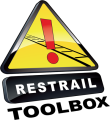20.2 Warning signs
This measure consists of provision of warning signs at stations and outside stations at locations where trespassing is frequent to deliver information about dangers related to trespassing. The aim is to increase the awareness of all railway trespassers about the dangers related to crossing the railway lines at illegal places.
- They should be informative and do not try to prohibit / dictate behaviour.
- Periodically check the condition of the signs and, if needed, make necessary actions to update their condition.
- A ’why not’ message is recommended with existing images supported by simple, clear messages, which spell out the consequences of ignoring the signs.
- Red and yellow are clearly understood as ’do not’ and ’danger’ colours, whilst circles and triangles link into nationally understood systems of instructional and warning signs.
- Consider the material to be used: metal, plastic, etc.
- Consider the priority locations and install in visible places. Have in mind the visual span and eyesight of the people you are targeting.
- Make sure that there is no more signage than absolutely necessary, otherwise people may overlook the signs.
- The effect of signage is highly depended on the amount of installed warning signs.
- The effect of warning signs is likely to be reduced over time. The effect can be maintained by replacing the old and grungy signs by new ones. The effect can be increased also by changing the content / design of the signs from time to time (e.g. a new sign every year or twice a year).
- The design of the signs/posters should be carefully planned. It might be that the same design is not effective in all cultures. For example some railway undertakings could disagree with the message shown as they might not like the depiction of a (recognizable, their company) train on a poster.
- It is important that the signs use a language that everyone can understand (i.e. removing old posters and replacing them with posters in a ‘modern’ language).
- Be careful with the message “trespassing is dangerous” this could attract possible suicidal persons to the tracks. It is better to address to “the delays caused by trespassers” and “the number of people that are inconvenienced by those delays”.
- Best to be combined with targeted campaigns, fencing, surveillance and enforcement.
- May also be combined with prohibitive signs. Placing signs with about the same message next to each other (e.g. one is an icon, the other a picture with text, the other is a prohibitive sign).
- Need support from station owners/operators etc. for space to post them and may compete with others for space (e.g. displacing advertising revenue).
- Station signage can be an effective way of reducing trespass (RSSB , 2005).
- Reduced trespassing behaviour by 30.7% (Silla & Luoma, 2011), but for one specific location in Finland.
- The potential of signs to change behaviour in the absence of any other activity is limited (RSSB , 2006).
- Implementation in the Cape Town rail system has done little to reduce injury rates (Lerer & Matzopoulos, 1996).
- Warning signs were tested by TCDD at Aydin station (Turkey) in combination with other measures and by CIDAUT in Valladolid Universidad station (Spain) as part of RESTRAIL pilot tests conducted in 2014.
last update: 2015-01-19 Print

